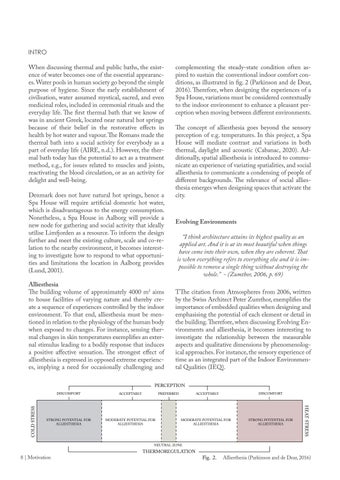INTRO When discussing thermal and public baths, the existence of water becomes one of the essential appearances. Water pools in human society go beyond the simple purpose of hygiene. Since the early establishment of civilisation, water assumed mystical, sacred, and even medicinal roles, included in ceremonial rituals and the everyday life. The first thermal bath that we know of was in ancient Greek, located near natural hot springs because of their belief in the restorative effects in health by hot water and vapour. The Romans made the thermal bath into a social activity for everybody as a part of everyday life (AIRE, n.d.). However, the thermal bath today has the potential to act as a treatment method, e.g., for issues related to muscles and joints, reactivating the blood circulation, or as an activity for delight and well-being. Denmark does not have natural hot springs, hence a Spa House will require artificial domestic hot water, which is disadvantageous to the energy consumption. Nonetheless, a Spa House in Aalborg will provide a new node for gathering and social activity that ideally utilise Limfjorden as a resource. To inform the design further and meet the existing culture, scale and co-relation to the nearby environment, it becomes interesting to investigate how to respond to what opportunities and limitations the location in Aalborg provides (Lund, 2001). Alliesthesia The building volume of approximately 4000 m2 aims to house facilities of varying nature and thereby create a sequence of experiences controlled by the indoor environment. To that end, alliesthesia must be mentioned in relation to the physiology of the human body when exposed to changes. For instance, sensing thermal changes in skin temperatures exemplifies an external stimulus leading to a bodily response that induces a positive affective sensation. The strongest effect of alliesthesia is expressed in opposed extreme experiences, implying a need for occasionally challenging and
complementing the steady-state condition often aspired to sustain the conventional indoor comfort conditions, as illustrated in fig. 2 (Parkinson and de Dear, 2016). Therefore, when designing the experiences of a Spa House, variations must be considered contextually to the indoor environment to enhance a pleasant perception when moving between different environments. The concept of alliesthesia goes beyond the sensory perception of e.g. temperatures. In this project, a Spa House will mediate contrast and variations in both thermal, daylight and acoustic (Cabanac, 2020). Additionally, spatial alliesthesia is introduced to communicate an experience of variating spatialities, and social alliesthesia to communicate a condensing of people of different backgrounds. The relevance of social alliesthesia emerges when designing spaces that activate the city.
Evolving Environments “I think architecture attains its highest quality as an applied art. And it is at its most beautiful when things have come into their own, when they are coherent. That is when everything refers to everything else and it is impossible to remove a single thing without destroying the whole.” - (Zumthor, 2006, p. 69) TThe citation from Atmospheres from 2006, written by the Swiss Architect Peter Zumthor, exemplifies the importance of embedded qualities when designing and emphasising the potential of each element or detail in the building. Therefore, when discussing Evolving Environments and alliesthesia, it becomes interesting to investigate the relationship between the measurable aspects and qualitative dimensions by phenomenological approaches. For instance, the sensory experience of time as an integrated part of the Indoor Environmental Qualities (IEQ).
DISCOMFORT
ACCEPTABLY
STRONG POTENTIAL FOR ALLIESTHESIA
MODERATE POTENTIAL FOR ALLIESTHESIA
PREFERRED
DISCOMFORT
ACCEPTABLY
MODERATE POTENTIAL FOR ALLIESTHESIA
STRONG POTENTIAL FOR ALLIESTHESIA
HEAT STRESS
COLD STRESS
PERCEPTION
NEUTRAL ZONE
8 | Motivation
THERMOREGULATION
Fig. 2.
Alliesthesia (Parkinson and de Dear, 2016)




